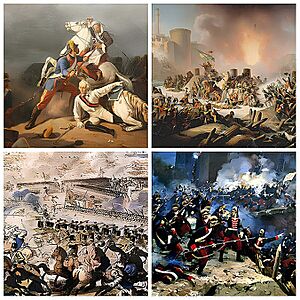Russo-Turkish War (1787–1792) facts for kids
Quick facts for kids Russo-Turkish War (1787–1792) |
|||||||||
|---|---|---|---|---|---|---|---|---|---|
| Part of the series of Russo-Turkish wars | |||||||||
 Clockwise, from top left: The Battle of Kinburn, The Siege of Ochakov, The Siege of Izmail, The Battle of Rymnik |
|||||||||
|
|||||||||
| Belligerents | |||||||||
|
|
|
||||||||
| Commanders and leaders | |||||||||
(1787–1789) (1789–1792) |
|||||||||
| Strength | |||||||||
| Casualties and losses | |||||||||
The Russo-Turkish War of 1787–1792 was a big conflict between the Russian Empire and the Ottoman Empire. The Ottoman Empire tried to get back lands it had lost to Russia in an earlier war (1768–1774). But they were not successful.
This war happened at the same time as other conflicts. These included the Austro-Turkish War (1788–1791) and the Russo-Swedish War (1788–1790).
During the war, Russian forces captured important places. On September 25, 1789, a Russian army led by Alexander Suvorov and Ivan Gudovich took Khadjibey and Yeni Dünya. Later, in 1794, the city of Odesa was founded there. This was ordered by the Russian Empress Catherine the Great.
Russia officially gained control of the Sanjak of Özi (Ochakiv Oblast) in 1792. This area became part of the Yekaterinoslav Viceroyalty. Russia also took full control of Crimea. They gained land between the Southern Bug and the Dniester rivers.
Why the War Started
In 1787, Catherine II, the Empress of Russia, took a grand trip. She traveled through new Russian lands and the recently added Crimea. Her ally, Joseph II, Holy Roman Emperor, joined her.
These events made people in the Ottoman capital, Constantinople, nervous. There were also rumors about Catherine's "Greek Plan". This plan was thought to be about creating a new Christian empire. Also, both sides complained that the other was breaking the Treaty of Küçük Kaynarca. This treaty had ended the last war.
British and French ambassadors supported the Ottoman side. This made the Ottomans more eager for war.
The War Begins
In 1787, the Ottomans demanded that Russia leave Crimea. They also wanted Russia to give up its lands near the Black Sea. Russia saw this demand as a reason for war, or a casus belli.
Russia declared war on August 19, 1787. The Ottomans then put the Russian ambassador, Yakov Bulgakov, in prison. The Ottoman Empire was not ready for war, and the timing was bad. Russia and Austria had formed an alliance. The Ottomans gathered their forces from all over their empire. Süleyman Bey Capanoğlu from Anatolia led 4,000 soldiers to the front lines.
The Ottoman Empire started by attacking two forts near Kinburn in southern Ukraine. Russian General Alexander Suvorov successfully defended against these attacks. He stopped two Ottoman attacks by sea in September and October 1787. This helped secure Crimea for Russia.
In Moldavia, Russian troops captured the Ottoman cities of Chocim and Jassy. The city of Ochakov, located at the mouth of the Dnieper River, fell on December 6, 1788. This happened after a six-month siege led by Prince Grigory Potemkin and Suvorov.
Even though they lost many battles to the Russians, the Ottomans had some success against the Austrians. The Austrian forces were led by Emperor Joseph II in Serbia and Transylvania.
By 1789, Russian and Austrian forces were pushing the Ottoman Empire back in Moldavia. Things got worse for the Ottomans. On August 1, the Russians under Suvorov won a battle against the Ottomans at Focsani. The Ottoman forces were led by Osman Pasha. Then, on September 22, the Russians won another big victory at Rymnik. This pushed the Ottomans away from the Râmnicul Sărat river. Suvorov was given the title Count Rymniksky for his victory.
The Ottomans faced more losses. The Austrians, led by General Ernst Gideon von Laudon, stopped an Ottoman attack on Croatia. Then, an Austrian counterattack captured Belgrade.
A Greek revolt also began. This revolt made it harder for the Ottomans to fight the war. It led to a truce between the Ottoman Empire and Austria.
Meanwhile, the Russians kept moving forward. In December 1790, Suvorov captured the Ottoman fortress of Izmail. This fortress was thought to be impossible to capture. This victory was also helped by Fyodor Ushakov's victory at Tendra.
A final Ottoman defeat happened at Machin on July 9, 1791. Russia was also worried that Prussia might join the war. These reasons led to a truce agreed upon on July 31, 1791. After taking Izmail, Suvorov marched towards Constantinople (today's Istanbul). The Russians hoped to create a Christian empire there. However, Suvorov was moved to Finland in 1791.
What Happened Next
The war officially ended with the Treaty of Jassy. This treaty was signed on January 9, 1792. It confirmed that Russia now owned the Crimean Khanate, which Russia had taken in 1783.
Yedisan (which included Odessa and Ochakov) was also given to Russia. The Dniester River became the new border for Russia in Europe. The Russian border in Asia, the Kuban River, stayed the same.
The Ottoman Empire's main goal was to get Crimea back. But they failed. If the French Revolution had not happened, the Ottoman Empire's situation might have been even worse.
See also
- Anapa Campaign (1787) — First Russian campaign against the Anapa fortress
- Anapa Campaign (1788) — Second Russian campaign against the Anapa fortress
- Anapa Campaign (1790) — Third Russian campaign against the Anapa fortress
- Siege of Anapa (1791) — successful Russian siege and capture of the Anapa fortress


